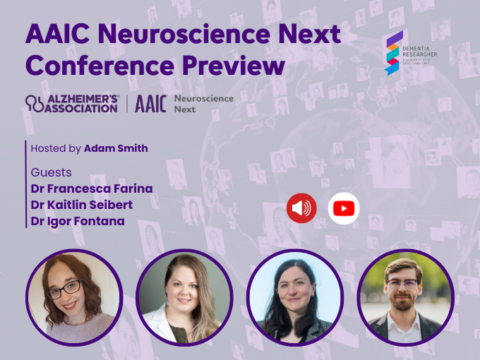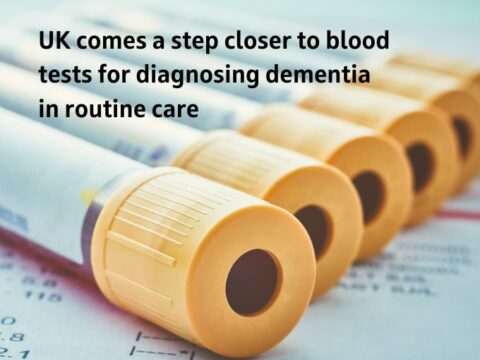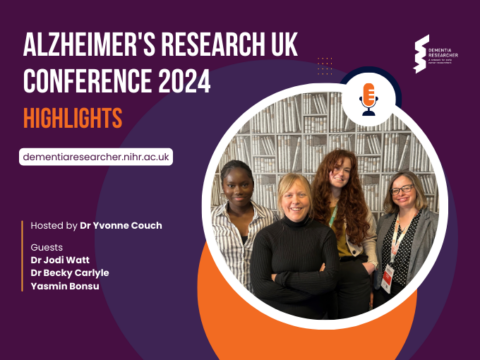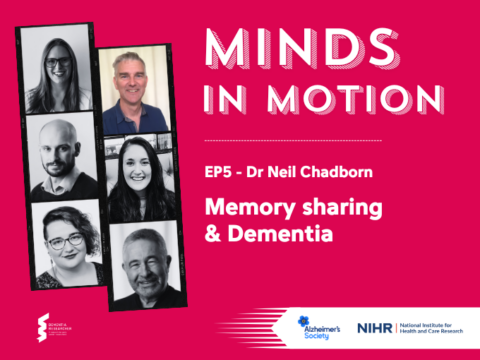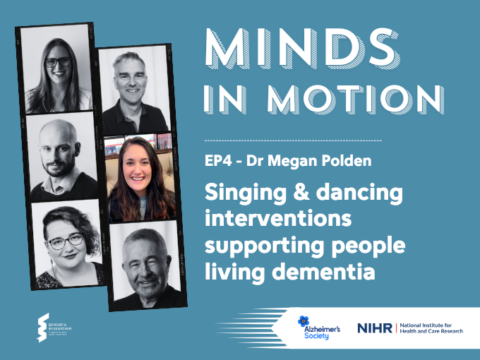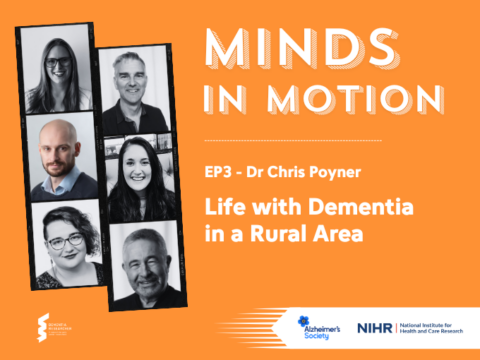Cohorts and the data collected from them through longitudinal research studies have made a significant impact on our understanding of disease. With funding from the Medical Research Council, Dementias Platform UK (DPUK) has been at the forefront of this work for the past 5 years, providing dementia researchers with free access to more than 3 million health records from over 40 cohort studies, and a powerful, secure analytics platform.
In our first ever ‘live recording’ we invited the audience into our virtual studio to watch Dr Megan O’Hare host a discussion on DPUK. Listen to discover what DPUK is, how it works, how it is helping researchers and how you can use the service.
Guests on the show are Cognitive Neuropsychologist, Dr Sarah Baumeister, Senior Data & Science Manager from DPUK and University of Oxford and multi-disciplinary researcher Dr Danielle Newby, also from the University of Oxford. With a background in epidemiology, pharmacology and machine learning. Danielle is currently using DPUK to explore options for repurposing existing drugs for use in dementia.
Adam Smith looks after the audience, and puts their questions to the panel at the end of the show.
For information on Dementias Platform UK visit:
https://www.dementiasplatform.uk/
Voice Over:
Welcome to the NIHR Dementia Researcher podcast, brought to you by dementiaresearcher.nihr.ac.uk. In association with Alzheimer’s Research UK, and Alzheimer’s Society, supporting early career dementia researchers across the world.
Dr Megan O’Hare:
Hello everyone, and welcome to another podcast, brought to you by Dementia Researcher website. And hello to everyone joining our live recording. I am joined today by Dr. Sarah Bauermeister, senior researcher and senior data manager at the University of Oxford and DPUK. And Dr. Danielle Newby, a postdoctoral researcher based at the Department of Psychiatry at the University of Oxford. And today we are going to be talking about the DPUK, Dementias Platform UK, and their data portal, which is a platform that gives dementia researchers access to more than 3 million health records from over 40 cohorts studies, in a secure remote free to access resource. And this data portal is a key part of the activities of DPUK, which in itself is a public and private funded partnership with the MRC to speed up progress in dementia research.
Dr Megan O’Hare:
So researchers from anywhere in the world can design studies or research questions, and apply for access to the relevant cohorts. Now, I’ve taken all that spiel just from what you guys sent in, so hopefully we can flesh that out a bit and also learn a bit about… Because you’re both using the data portal to answer your own research questions, so we definitely want to hear about that.
Dr Megan O’Hare:
So coming onto that, one study led by Sarah is looking into the links between adverse experiences in childhood and later life cognitive outcomes. And another study led by Danielle is looking at the potential repurposing of existing drugs, so ones used for hypertension or diabetes, to address cognitive decline. If you’d both like to do a quick round table, introduce yourselves, a bit of your background and how you came to be working at the DPUK. Should we start with you, Sarah?
Dr Sarah Bauermeister:
Yes. Hi everybody. So I’ve got two hats, basically. I am senior data manager for DPUK, so I’m responsible for reviewing the applications that come through DPUK, and also helping to manage basically the data portal and platform. So that’s my one hat, and my other hat is that I am also a senior scientist. So I actually do conduct and manage research on the data portal. And as Megan said, I have my own research program investigating early experiences and later life dementia. So I run a project and I have analysts working, investigating this, using data portal cohorts, and we’re running that project at the moment.
Dr Megan O’Hare:
Okay. Can I just ask, so you solely use the data from the data portal for your research? You’re not doing any, I don’t know, focus groups or anything outside of that, it’s all data from the data portal?
Dr Sarah Bauermeister:
Actually, no. We actually are using DPUK cohorts. We also use cohorts from outside of DPUK, which we have uploaded onto the platform, which we analyse alongside DPUK cohorts. We are also involved in an international project, where we’re using my project as a pilot project. And we’re also building this program and we are applying for funding to expand this into a global network of research. Yes.
Dr Megan O’Hare:
Mm-hmm (affirmative). Okay. And all the DPUK cohort data is UK-based data, is it?
Dr Sarah Bauermeister:
No, we do have cohorts which are based in, for example, we have some Korean, and we have also American cohorts as well. So it’s predominantly UK-based, but we do have some international cohorts as well. Some of the cohorts which I brought in for my project is based in Australia, and the United States as well.
Dr Megan O’Hare:
And when you say you brought them in, they weren’t already on DPUK, you’ve made a collaboration, and so now the cohorts are available to everyone? Or you mean you’ve brought them in just solely for your project?
Dr Sarah Bauermeister:
Yes, that’s correct. So in other words, I’ve applied for the data as an external applicant. And with that permission, I have uploaded them on the portal, I’m using them for my project, and at the end of my project, I will remove them from DPUK. So, they will not become a DPUK cohort, but with permission, I am using the infrastructure of DPUK to analyse them alongside DPUK cohorts.
Dr Megan O’Hare:
Okay, great. Danielle, should we have a quick intro from you?
Dr Danielle Newby:
Yeah, Sure. So hi everyone. My name is Danielle I’m, as Megan’s already introduced, I’m a postdoc from Oxford in the Department of Psychiatry. And again, I’ve got kind of a really multi-disciplinary background. So I’ve kind of got a bit of machine learning, pharmacology, so from pharmacy. And then with the epidemiology, so looking at data. And I’m really interested in understanding the causes of dementia, so risk factors. And also, on the other hand, trying to find, as Megan said, potential treatments to reduce dementia risk and also improve brain health. And the way that I do that is to use real world data or data that’s already available, such as those cohorts that are in the DPUK platform.
Dr Megan O’Hare:
Okay, great. So let’s move on to discussing, we touched on it a bit, Sarah, but the data portal, and how is a unique research resource for ECRs. Maybe you could talk a bit about that.
Dr Sarah Bauermeister:
So DPUK is a free to use resource, and that is free because the data are uploaded onto the platform by our cohort owners. It’s never downloaded. It resides in the data repository. And researchers, whether they’re from industry or academia, can access these data sets from anywhere across the world. So they submit a full project proposal. And once this proposal has gone through an approval process by the cohort owners, we then facilitate the opening of a data portal account, and they gain access to work on these data sets on the data portal.
Dr Sarah Bauermeister:
And this goes for any Bonafede researcher. And all we require is that if they are perhaps a junior researcher, that they have maybe a supervisor as a co-applicant on their project proposal. And where this is really great for early career researchers is that some of these large cohort data sets are really inaccessible for junior researchers. And they’ve come together in one place. And so if you apply for example, five cohorts, they are all in one project folder on the data portal. And all the statistical tools for analysing these cohorts are free to use on the data portal. And that includes, for example, STATA, the license for STATA, for a researcher with no funding, it’s really expensive, but these tools are free to use for early career researcher, or for anybody, really.
Dr Megan O’Hare:
And you said academia or industry, because you have got partners that are pharma, biotech, and academia, so any Bonafede researchers can use it?
Dr Sarah Bauermeister:
That’s correct. So, if you are a Bonafede researcher, that can be pharma, any industry or academic, you can access these datasets. Yes.
Dr Megan O’Hare:
Okay. And you said at the beginning that you review the applications. So what does that entail? Can you talk us through your review process?
Dr Sarah Bauermeister:
So the review, so at DPUK, we never own these datasets. The ownership always belongs with the cohort owners. And all we do for DPUK, we just provide a service looking for what we call egregious science. So what we want is we want sensible applications to go out to our cohort owners to review. So for example, we will just make sure that these applications are sensible and that they are complete. So we have videos, we have user guides on our websites for applicants, so they can go and access these user guides and see how to complete a proposal efficiently and properly. And we will just simply reviews those applicants. And if we find there’s a section, for example, where the analysis section is not really competed properly, or perhaps they don’t tie in with the proposal, we’ll send it back, give them advice how to complete that properly. And when we think that proposal is sufficient, we will then send that out to the cohort owners to decide about access to their dataset.
Dr Megan O’Hare:
Okay. And you said you have 40 cohorts, is that right?
Dr Sarah Bauermeister:
42 cohorts, yes.
Dr Megan O’Hare:
42 cohorts. Yeah. Okay. And you can apply to get data from all 42, should you wish?
Dr Sarah Bauermeister:
Should you wish, and/or if your research question warrants accessing 42 cohorts. These cohorts have heterogeneity across all types of data, and there’ll be data in one cohort which really suits your research question, but there might not be those data types in another cohort. So it will be very rare that you’d need all 42 cohorts.
Dr Megan O’Hare:
You never know, though.
Dr Sarah Bauermeister:
But you never know.
Dr Megan O’Hare:
And I just wondered, this might be quite a naive question, but you have 3 million participants in 42 cohorts. How many of those have a dementia diagnosis?
Dr Sarah Bauermeister:
Now, that’s a very difficult question because dementia diagnosis is incredibly complex, and these cohorts are not necessarily dementia specific. Although we called Dementias Platform UK, our cohorts are typically population and birth cohorts that have not collected data for a dementia specific purpose. They’ve perhaps collected the data for cardiovascular disease, or cancer, or even Huntington’s disease. And what they’ve done, they’ve entrusted us with their data to repurpose it for dementia research. So off the top of my head, I can’t give you an exact number of cohorts that have collected a measure for dementia.
Dr Sarah Bauermeister:
Also, as I said in the beginning, it is very difficult to say, “Well, this is a measure for dementia.” Perhaps there is a clinical assessment, perhaps there is a measure that says, “Have you been diagnosed with dementia? Tick yes, no.” So it’s very difficult for me to say this number has actually got a dementia diagnosis.
Dr Megan O’Hare:
And I guess the key that you said there is it’s repurposing data that’s already been collected, and is being offered up, open-access in a way, for other people to ask a research question of.
Dr Sarah Bauermeister:
Exactly. It’s a bit like Danielle’s research that she’s doing, re-purposing. And I think she’s very experienced to say how she’s repurchasing her research for another purpose.
Dr Megan O’Hare:
Yeah. Actually, Danielle, maybe we could come on to you and talk to you a bit about your projects, and how you’re using DPUK.
Dr Danielle Newby:
Yeah, sure. What do you want to know?
Dr Megan O’Hare:
Everything. How many cohorts are you using? 42?
Dr Danielle Newby:
No, God no. I’m not using 42. Well, like Sarah says, the most important thing is trying to find out the cohorts you actually want to need that can actually answer your research question. And the good thing about the DPUK website and the portal is that they’ve got this kind of matrix, where you can basically… It’s like phenotyping the cohort. So you can see, does it have a dementia diagnosis? Does it have blood pressure? Because obviously I’m looking at cardiovascular disease, blood pressure’s a really important measure that I need.
Dr Danielle Newby:
So I’m able to grab the cohorts that I need, that are specific for my question. So my question’s related to cardiovascular metabolic. So I identified, I think it was five. And then also additionally to that, I’m using UK Biobank. But like Sarah said, the good thing about that is obviously I’m analysing my data of those five cohorts in the DPUK platform, and I can also upload my UK Biobank data and analyse it alongside it. So it has that kind of added benefit of I’ve got my code in one place in a secure platform, I’ve got my unidentified data and I can streamline everything because I haven’t got codes in different places, data in different places. So it offers that real streamlining and making my research a lot more smoother in that sense.
Dr Megan O’Hare:
So does UK Biobank not do that the other way as well if you’d gone to them first? Do you see what I mean? You’ve got their cohort data, and then you could pull in DPUK’s, or are you saying that basically DPUK acts as a central place where you can pool all your resources, and then you’ve got access, like you said, Sarah, to free statistical analysis software and whatever?
Dr Danielle Newby:
Yeah, I think so. As long as you’ve got the permission. You’ve always got to have the permission of the cohort to do that. If you haven’t, then obviously you can’t. But yeah. Yeah.
Dr Megan O’Hare:
Okay. So you’re looking at repurposing drugs within cardiovascular disease, is that right? But also looking at [inaudible 00:14:40] decline?
Dr Danielle Newby:
Yeah. There’s 12 risk factors for dementia that’s come from the Lancet Commission led by Gill Livingston, that there are certain things that can increase your risk of dementia in later life. And if you think about that, those things increase your risk. So there’s the hypothesis that maybe the drugs used to treat those risk factors could reduce dementia risk and slow cognitive decline, so that’s the question I’m asking. In the DPUK project that I’m working on, I’m looking at cardiovascular and also anti-diabetics so diabetes as well. But it’s basically a lot of other drugs could be as well. But a lot of people do have high blood pressure in midlife. So I’ve got to think about it for a point-of-view that there’s going to be more people that are potentially taking those medications. So I’ll have the samples in order to answer my question. So that’s why I’ve specifically focused on cardiovascular, but there are other potential ones that we can repurpose. And I look at any really, but that’s the one that I’m interested in at this moment in time.
Dr Megan O’Hare:
Okay. And you sort of touched on the matrix system, and so you can go through and look at the cohorts that would be most specific for your project or most useful for your project. But what data can people access? I was looking at the website and it says you’ve got networks with imaging, STEM cells, informatics. What other kind of data have you got? Maybe Sarah.
Dr Sarah Bauermeister:
So on the data portal, we have a suite of what we call data visualization tools. And as Danielle said, we have the cohort matrix. And that matrix breaks down all our data into 22 categories of data. So each cohort, what we do is when the cohort comes in, we categorize their data across these 22 categories of data. So for a cohort such as Biobank, they will have data within all 22 of those categories. And that can be everything from social demographics, to omics, to genetic, to imaging, to you’ve got your biomedical data, you’ve got your mental health data, you’ve got your lifestyle, your environmental data, your digital phenotyping data. So incredibly vast, incredibly diverse and rich.
Dr Sarah Bauermeister:
And then you have your smaller cohorts, which as I said in the beginning, have been collected for a very specific purpose. So say cardiovascular disease. Across those 22 categories, they might only maybe have data across 10 or 11 of those categories, because it’s been very focused on cardiovascular disease, socio demographics, and administrative. So it really does depend on what the cohort set out to do in the beginning. And that’s why when you said, about the research question, “Would they apply for all 42 cohorts?” It would really depend on the research question. And that’s where the matrix comes in. It gives everyone a broad overview thinking, “Oh, I need mental health. Let me have a quick look who has mental health.” And it’s simply a tick next to mental health.
Dr Sarah Bauermeister:
And then we go on to the cohort directory. And on the cohort directory, not only can they see these cohorts have mental health for example, but they can click into the cohorts, find out all about the cohort, when the data were connected, how many waves of data, or a website, supporting material. But they can also see across each of the waves, for example, let’s take mental health for example, depression and what type of scale was used to collect depression. So if we have a cohort with 12 longitudinal waves of data, they can see that depression was collected using the GHQ scale in waves five, six, and seven. And for a statistical modeler, who is using latent growth curve modelling, that is important because they need to know it’s being collected in three waves of data.
Dr Sarah Bauermeister:
So our tools are a very important part of applying for data, so that by the time applicant submits their applications through the system, they have a very clear idea that I need these six cohorts, because I know these six cohorts have the data I want to apply for. That’s why I say it would be very rare to get someone applying for 42 cohorts, because then I think we have failed in our tools.
Dr Megan O’Hare:
Okay, fine. Let’s drop the 42 cohorts question.
Dr Sarah Bauermeister:
You cans see, this is a sole point if someone applied for 42.
Dr Megan O’Hare:
I’m definitely not going to do that then. Okay.
Dr Danielle Newby:
Sarah, I think I might just do an application, I want all 42.
Dr Sarah Bauermeister:
I’ve rejected it live.
Dr Megan O’Hare:
So something on the front page of the DPUK website is about detecting and treating earlier, and how your data, the data portal can really help start to treat earlier. Because Danielle, you’re doing cardiovascular, cognitive decline, but you are looking earlier in the treatment pathway. Is that right?
Dr Danielle Newby:
Yeah, yeah, yeah. Because we’ve got all of that information from all of the waves, or over time, we can see from a person who, for example, started the study and didn’t have a diagnosis of dementia or look at their cognition at baseline, we call it. And then look over time, and see, obviously, as you get older, your cognition does decline very slowly. But then we can compare those who potentially have hypertension or don’t have hypertension, and see how their decline differs. And then we can look at of those people who’ve got hypertension, are they taking drugs? What sorts of drugs are they taking? And does that actually influence how fast or slow their decline is?
Dr Danielle Newby:
So yeah, you can look back. You’ve almost got of their whole span of the time they’d been in that study. And you can, like you say, look earlier because you can see how they’ve progressed through the times of the study.
Dr Megan O’Hare:
Yes. Quite a lot of the cohort studies are longitudinal studies over many years. Is that right? Are they still being added to, with new data?
Dr Danielle Newby:
Well, from my experience, some of them, yes. But Sarah will probably have more experience with the ones in DPUK portal. The ones that I know, that I’m using in DPUK, I know that they’re adding additional waves. But Sarah, over to you.
Dr Sarah Bauermeister:
Yes. That’s true. As Danielle said, some of our cohorts are still actively collecting, such as ELSA. The English Longitudinal Study of Aging, that’s a lovely study. They’ve just added a ninth wave, including COVID data. So they are a real champion for DPUK. So they are actively connecting data, approximately, I stand to be corrected every 18 months. But then we do have some of our historical cohorts who’ve finished connecting, but nonetheless, are incredibly valuable and they are still highly prized as a valuable… Such as the Caerphilly study. So yes.
Dr Megan O’Hare:
So which one’s that, sorry?
Dr Sarah Bauermeister:
The Caerphilly study, which has finished collecting data, but we still get a lot of requests for that study, which was an original cardiovascular study. So a very rich cohort and valuable data.
Dr Danielle Newby:
Yeah. So I use that one for this study that… Because even though it’s a smaller subset and it’s in men, they’ve really asked lots of questions. They’ve been heavily phenotyped, so they’ve got a richness of data that is going to be really important to help support the analysis of my other cohorts because it’s got that wealth of data within it.
Dr Megan O’Hare:
Okay. Did you say it’s mainly men? That was just the study was set up that way? Yeah. Okay, great. So Adam, I wonder if we’ve had any questions from our audience?
Adam Smith:
We do have a question from the Zoom recording, [Mustapha Atti 00:00:23:58], “Does the dataset have dementia subtypes, medical comorbidities and medications profiles?”
Dr Megan O’Hare:
Sarah?
Dr Sarah Bauermeister:
I can say yes to medications and medical co-morbidities. A lot of our larger cohorts do you have that. Off the top of my head, for example, ELSA, Whitehall, NSHD studies. Those larger cohorts do have those types of information. As for dementia subtypes, again, when I mentioned about the difficulty with dementia diagnosis in our cohorts, the subtypes are also quite difficult to obtain. However, with some of our cohorts, there is linkage, and this is where you would be able to acquire this additional information. And those would be, for example, with UK Biobank.
Adam Smith:
Question from me, is could researchers contribute their own data to the DPUK platform if they wanted to? If you’ve collect to the large amount of information as part of a particular trial or as part of a PhD, could that data, with the right consent, be offered up to DPUK to add to the pool of data, if you like?
Dr Sarah Bauermeister:
Absolutely. We would absolutely love that. I think that this is what we’re all about. We are a data sharing platform. And I would very much welcome any discussions. And please do contact me if you have a data set that you would like to share with others. And I would welcome that discussion. Yes.
Adam Smith:
So this is another question from Adam Smith. Can you see things like scans? Can you see the actual image or do you just gain access to the report, the scan report?
Dr Sarah Bauermeister:
Are you talking about MRIs?
Adam Smith:
Yes. MRIs, or PET scans, or things.
Dr Sarah Bauermeister:
Imaging? It depends. It depends what you would like. So if you are an analyst such as myself, I am not an raw imaging analyst. I would like the IDPs, which is an image derived phenotype. So I would like someone to do all the processing for me, and just give me the numbers to put into my structured equation model. I’m quite happy with that. But my imaging analyst, she would like the raw data uploaded from Xnet, and she wants to peer over the images in a Linux machine. So it is entirely up to you, what type of analyst you are, and where your skills lie and what cohort you apply to that have those raw image data. Yes.
Adam Smith:
Fantastic. We have a question on YouTube, which asks about the costs or charges for using this. I don’t know if that was addressed earlier.
Dr Sarah Bauermeister:
So the cost for using the data portal are absolutely free. The only cohort which incur a charge are UK Biobank, and their costs are available on their website. Whitehall incur a charge as well, and their charges are on their website as well. Our other cohorts are free. And it is a free to use resource. Correction, the ALSPAC cohort, they also have a charge and their charges are also on their website. But only those three cohorts who charge at source.
Adam Smith:
Thank you. Also, this question may have been asked earlier. But am I right in assuming that this can be used by anybody across the world with the right granted access?
Dr Sarah Bauermeister:
Yes, yes. That is correct. So, anyone anywhere in the world can apply for a data portal account, all you need is an academic or industry email address and be a Bonafede researcher.
Dr Megan O’Hare:
I actually had a question. So once I’ve used the data, how does it work if I publish? So I obviously acknowledge where I’ve got the data from. Is it a collaboration? So you’d also be on my paper. Do you see what I mean? How do I acknowledge the use of the data?
Dr Sarah Bauermeister:
We have a publication policy, which is available to download from our website. All that we require is that the cohorts you use our acknowledged in your research. And usually, if you read in the publication policy, selected cohorts would like to see what you are publishing before you actually publish it.
Dr Megan O’Hare:
Yeah, but DPUK itself doesn’t, because they’re just sort of hosting all the cohorts?
Dr Sarah Bauermeister:
We are hosting and we just want to be acknowledged, and our funders. MRC funds us, and there will be an acknowledgement that you acknowledge in the acknowledgements of your publication, and also any presentations that you make as an output of your analyses. Yes.
Dr Megan O’Hare:
Is that the same if you’re doing a presentation, you need to run it by the cohort you’ve used, if they specified that, do you think?
Dr Sarah Bauermeister:
I think usually for presentations, such as a poster or an oral, I think we’re fine there. But for a journal publication, usually you’d run that past the cohort owners.
Dr Megan O’Hare:
Yeah. So Sarah, I think the DPUK has been re-funded, is that right?
Dr Sarah Bauermeister:
Yes. That’s correct. MRC has funded us for another five years. We’re incredibly thankful to the MRC for re-funding us again. And we’re really excited about the future as we move into the new phase of DPUK, where we’re going to increasingly carry on developing the data portal. Some of the tools that I mentioned in our initial interview [inaudible 00:30:09], we want to develop them so that they’re world-class. They do the job at the moment, but we would like them to do the job brilliantly. We want to be able to develop feasibility tools, so the analysts can come along and compare cohorts next to each other, so that they can select a group of participants that have blood pressure, and smoking, and alcohol, and they can select cohorts. So we want to develop those tools into world-class tools. That’s part of DPUK2, and the development program.
Dr Sarah Bauermeister:
We also are developing our data curation. So we are curating our cohorts so that we are standardizing the naming structure across our cohorts. So, for example, slices of bread with butter, we want to make sure that that is named the same across all our cohorts, so that a researcher can analyse that and compare and contrast across each cohort. That data curation is time consuming, and that will move into DPUK2, so that we can develop that program of work.
Dr Sarah Bauermeister:
Also, our experimental medicine program, that is moving, that is DPUK2, that will be launched moving forward. And of course, our great minds trial delivery framework and clinical studies register, that is all to be launched for DPUK2. So very exciting moving into the renewal, and we’re really hopeful that great things are going to happen for dementias research. Yes.
Dr Megan O’Hare:
Sounds great. So Danielle, how hopeful will that be for your work?
Dr Danielle Newby:
That will be really, really helpful. When Sarah was saying all this, I was like, “Oh my God, that’s amazing. I can’t wait for this to come out. When’s it going to come out?” Yeah, it will be so useful because the main thing, the analysis part is the quickest part of doing your work. The longest part is cleaning the data, that takes ages. And if they’ve already done it, or they’ve already done parts of it and standardized it and everything, that saves me like six months. So that’s really, really good. That’s really exciting. And yeah. No, it’s really, really helpful. As an early career researcher, we’re kind of on multiple projects, fingers in many pies, all this sort of thing, and trying to get to that next level.
Dr Danielle Newby:
So by having all of the support that DPUK provides, that is helping me get to my next stage. And also, just to shout out like Mark Newbury and the technical support team over in Swansea, who they help all the technical side of it, support. It wouldn’t be possible without them helping out. Putting up with my questions. When I’m like, “What’s this mean?” Just to say there’s a lot of things underneath the hood, there are a lot of people under the hood that helping with DPUK.
Dr Megan O’Hare:
That’s great. So kind of coming to the end of today, so should we do our call to action? Sarah, what are the take homes for all the ECRs listening? And maybe also just throw in your Twitter handles for everyone.
Dr Sarah Bauermeister:
Okay. So I really just want to encourage ECRs to really utilize this resource. The DPUK data portal is really just waiting to be accessed, and the data are there. It’s free to use, it’s free to access. And now during lockdown and when you have time on your hands, the tools are there for free. We’re very friendly, we’re very accessible here at DPUK. Please do drop me an email. I’m on Twitter @S_Bauermeister. I’m always posting feeds and information on Twitter. We have a data-thon series, where you can actually come along and access the data portal over a workshop period. We’ve taken it from face-to-face, we’ve taken it into a virtual COVID style where you can do it from home, and you can have a chance to see what the data portal is all about. So submit a proposal, try out the data portal at a data-thon. We really do welcome you. It’s an opportunity to get your foot on the research ladder.
Dr Megan O’Hare:
Yeah, great. Thank you. And we’ll put links to the data-thon and the website and stuff, and also your Twitter and contact details. Bye.
Dr Sarah Bauermeister:
Bye.
Voice Over:
Brought to you by dementiaresearcher.nihr.acu.uk. In association with Alzheimer’s Research UK and Alzheimer’s Society, supporting early career dementia researchers across the world.
END
Like what you hear? Please review, like, and share our podcast – and don’t forget to subscribe to ensure you never miss an episode.
If you would like to share your own experiences or discuss your research in a blog or on a podcast, drop us a line to adam.smith@nihr.ac.uk or find us on twitter @dem_researcher
You can find our podcast on iTunes, SoundCloud and Spotify (and most podcast apps) – our narrated blogs are now also available as a podcast.
This podcast is brought to you in association with Alzheimer’s Research UK and Alzheimer’s Society, who we thank for their ongoing support.
Have you used Dementias Platform UK? Share your experiences and reply below.

 Print This Post
Print This Post